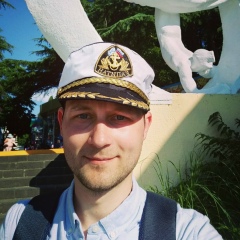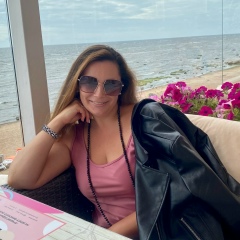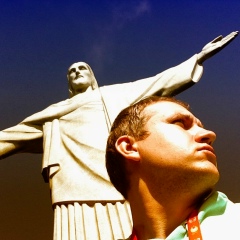Гостил пару дней в столице. Гулял мало: позагорал в Москва-сити, щурясь от ярких бликов солнца на стекляшках небоскребов, полюбовался огнями фонтанов на Поклонной горе, насладился архитектурным изяществом Никольской и Кузнецкого моста. В Камчатку так и не зашел, хнык хнык. Москва стала человечнее – изменение, обычно незаметное замыленному взгляду горожанина. Уже не столь напорист торговец розами на Киевской и агрессивен таксист на площади трех вокзалов. Но с прохожими по-прежнему лучше не шутить, ибо можно нарваться на грубость или непристойность (не зря же Москва заняла первое место в мире в рейтинге самых неприветливых городов). Невольно всплывают сравнения с Питером – ничего нового, понятно дело, я не скажу, но своими мыслями поделюсь. Пространственная структура города накладывает отпечаток на жителей. Здания, сооружения и районы в Москве удалены друг от друга на большие расстояния, разобщены. Это переносится на взаимоотношения между людьми, дополнительно охлаждающиеся большим разнообразием сплетенных здесь судеб (и, как следствие, непохожестью друг на друга), транспортной усталостью, перенаселенностью мегаполиса, страстью к быстрому обогащению. Хрестоматийна в этом отношении история банкира Урина, произошедшая несколько лет назад. Питер же сосредоточен, компактен, и люди там в большей степени тянутся друг к другу. В дополнение, как на Стамбул влияет Босфор, так на Питер влияет Балтийское море. Питерцы знают, что рядом с ними бескрайняя водная гладь, а чуть дальше на восток еще и Ладожское озеро, хотя оно и меньше ощущается. Москва же очень централизована и континентальна, и поэтому, в своем развитии тяготеет к России гораздо больше Питера. Москва замыкается в гигантизме зданий и проспектов (апогеем этого стремления должен был стать так и не выросший выше цокольного этажа Дворец Советов на месте Храма Христа Спасителя с мега статуей старика Ульянова на верхушке). Питер же славится «дворцовой умеренностью» и красотой архитектурных форм. Москва эклектична мирно соседствующими деревянной усадьбой с резными окнами, бетонно-бездушной громадиной завода, безликой советской многоэтажкой, белокаменной церквушкой 16го века и уродливым новоделом двухтысячных. Не верьте московскому адресу только с улицей и номером дома, требуйте номера строения или уточняйте, что его нет, ибо на огромной территории могут ютиться и сто домов с одним номером. Питер более консервативный, хотя и он может позволить себе заменить гряду исторических зданий одним торговым центром. Питер больше нацелен на сохранение, Москва – на изменение и преумножение. Мне нравится представлять город таким, каким видели его люди других времен, смотреть фотографии с давно исчезнувшими зданиями, осознавать, как меняется городская среда. В таких переменах – история городской жизни, а значит, и наших жизней. Например, каждый раз, когда я прохожу мимо вестибюля станции метро Площадь Восстания, я невольно вспоминаю Знаменскую церковь, разобранную советской властью в 1941 году. Мне хочется взглянуть на наши столицы в разных исторических эпохах. В каких-то из них я бы с опаской гулял по улицам и проспектам, в других же не особо бы беспокоился, но неизменно фланировал бы, замечая нюансы городского ландшафта и мелкие подробности жизни людей, подобно Гиляровскому, с огромным удовольствием.
I visited a couple of days in the capital. He walked a little: he sunbathed in Moscow City, squinting from the bright glare of the sun on the glass of skyscrapers, admiring the lights of the fountains on Poklonnaya Hill, enjoyed the architectural elegance of the Nikolskaya and Kuznetsky Bridge. In Kamchatka never went, sob sob. Moscow has become more humane — a change, usually imperceptible to the gaze of a city dweller. The trader of roses in Kievskaya is no longer as energetic and the taxi driver is aggressive in the area of three stations. But it is still better not to joke with passers-by, for it is possible to run into rudeness or obscenity (it’s not for nothing that Moscow took the first place in the world in the ranking of the most inhospitable cities). Comparisons with Peter involuntarily come up - nothing new, of course, I will not say, but I will share my thoughts. The spatial structure of the city affects the inhabitants. Buildings, structures and districts in Moscow are separated from each other by long distances, separated. This translates into relationships between people, which are additionally cooled by a large variety of destinies woven here (and, as a result, dissimilarity to each other), transport fatigue, overpopulation of the megalopolis, and a passion for rapid enrichment. A textbook in this respect is the story of the banker Urin, which occurred a few years ago. Peter is focused, compact, and people there are more drawn to each other. In addition, both the Bosphorus affects Istanbul, and the Baltic Sea affects Peter. Piterites know that there is a vast expanse of water near them, and Lake Ladoga is a little further to the east, although it is less felt. Moscow is very centralized and continental, and therefore, in its development, much more to Peter. Moscow closes in the gigantism of buildings and avenues (the apogee of this striving was to become the Palace of Soviets, which did not grow above the basement floor in place of the Cathedral of Christ the Savior with the mega statue of old Ulyanov on the top). Peter is famous for “palace moderation” and beauty of architectural forms. Moscow is eclectic, peacefully adjoining a wooden manor with carved windows, a concrete and heartless hulk of the factory, a faceless Soviet high-rise building, a white-stone chapel from the 16th century and an ugly new-made two thousandth. Do not believe the Moscow address only with the street and house number, ask for the building number or specify that it does not exist, because a hundred houses with one number can huddle in a huge area. Peter is more conservative, although he can afford to replace the chain of historic buildings with a single shopping center. Peter is more focused on preservation, Moscow is on change and multiplication. I like to imagine the city as it was seen by people of other times, to look at photos with long-disappeared buildings, to realize how the urban environment is changing. In such changes - the story of urban life, and hence our lives. For example, every time I walk past the lobby of the metro station Ploshchad Vosstaniya, I involuntarily recall the Znamenskaya Church, dismantled by the Soviet authorities in 1941. I want to look at our capitals in different historical eras. In some of them I would walk around the streets and avenues with caution, while in others I wouldn’t be particularly worried, but I would always wander, noticing the nuances of the urban landscape and small details of people's lives, like Gilyarovsky, with great pleasure.



У записи 23 лайков,
0 репостов.
0 репостов.
Эту запись оставил(а) на своей стене Сергей Дуванов












































